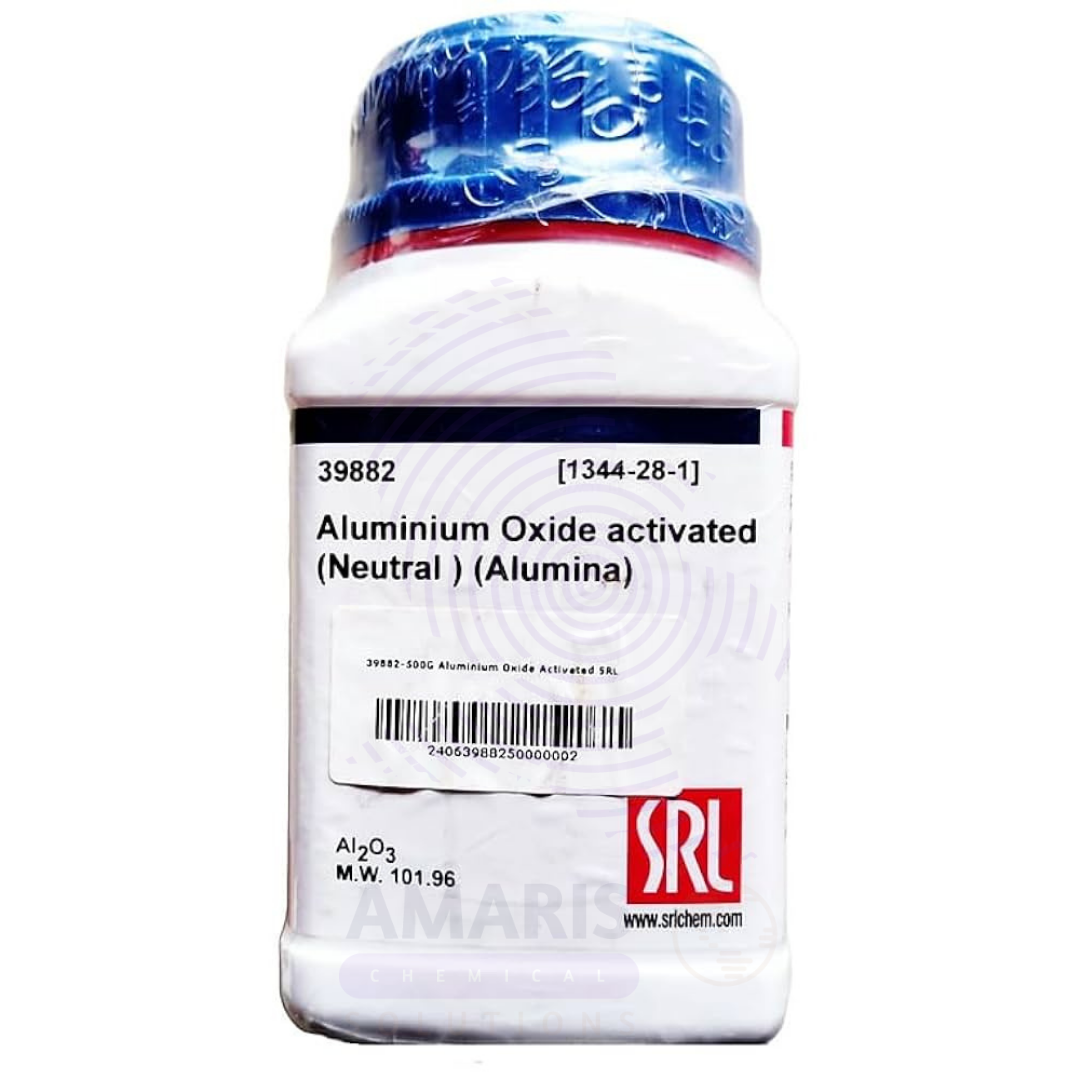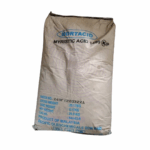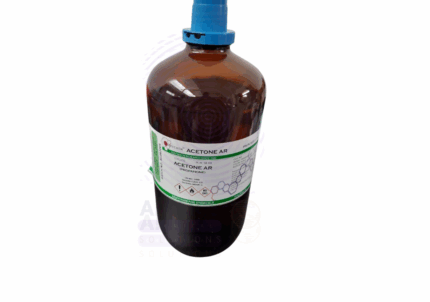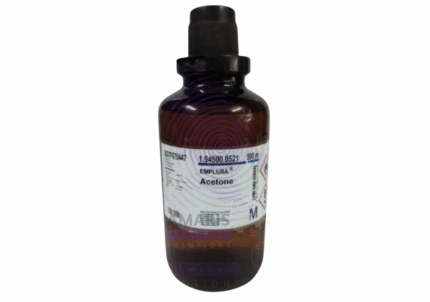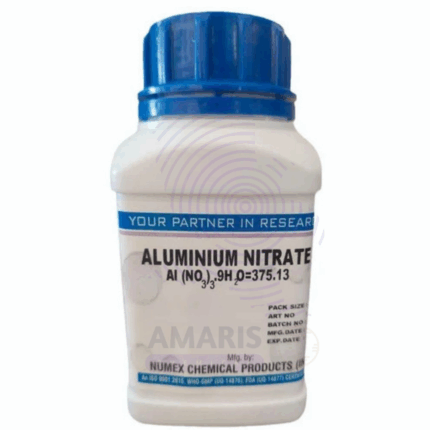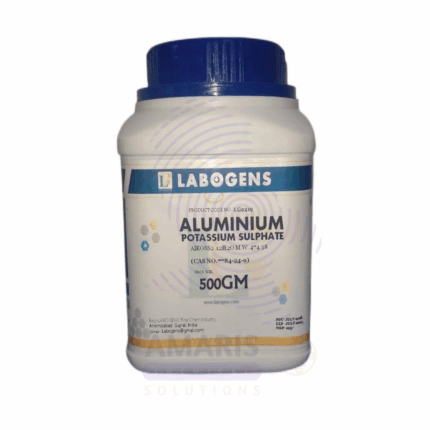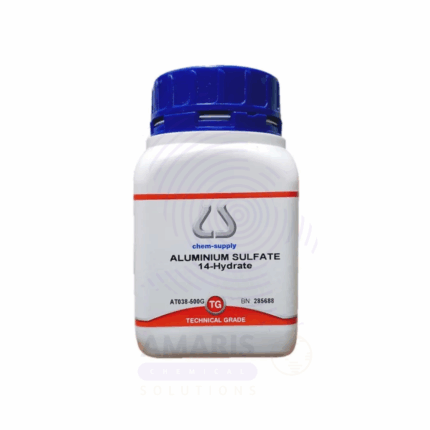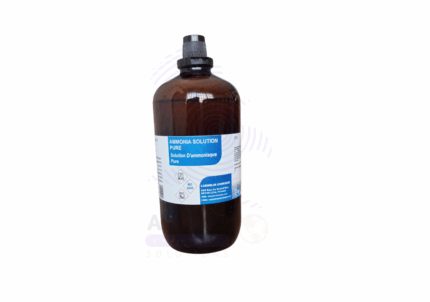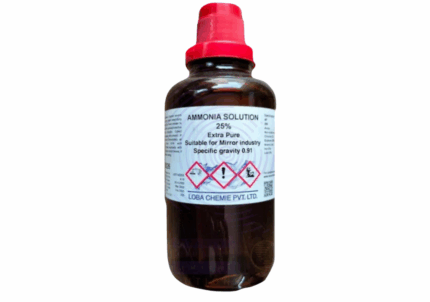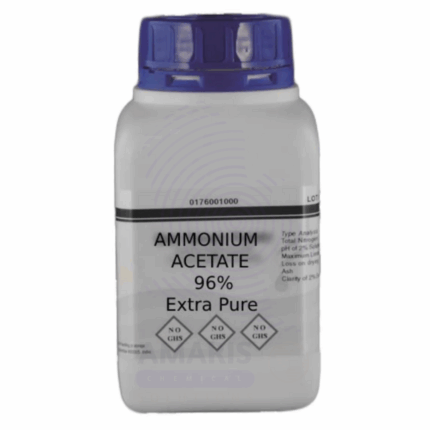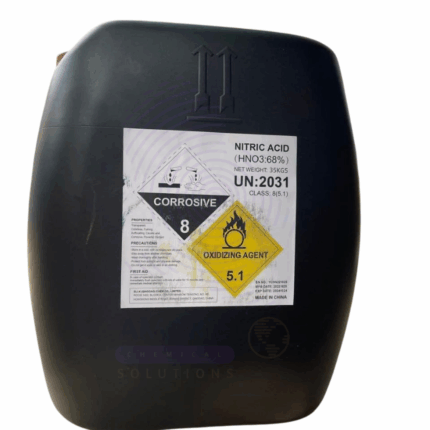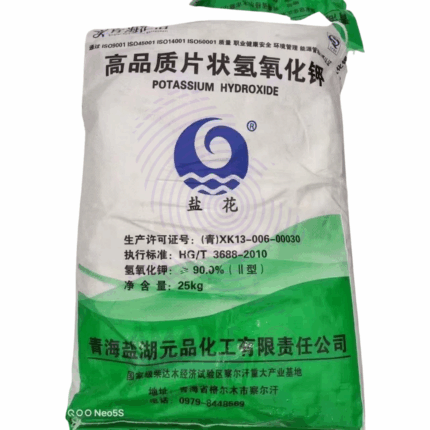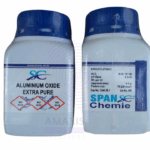
Aluminium Oxide Active Neutral Extra Pure
$ 22.00 Original price was: $ 22.00.$ 21.45Current price is: $ 21.45.
Aluminium Oxide Active Neutral Extra Pure is a high-purity, fine white powder known for its high surface area and neutral pH, making it ideal for chromatography, adsorption, and catalyst support in laboratory research. Its active form ensures excellent capacity for separating and purifying organic compounds without altering their chemical structure, especially in column chromatography applications. Commonly used in analytical, organic synthesis, and material science laboratories, it provides consistent performance in adsorption studies, drying of solvents, and reaction monitoring. The extra pure grade ensures extremely low levels of impurities, suitable for high-precision experimental work. To maintain its activity, it should be stored in airtight containers away from moisture and reactive chemicals.
Aluminium Oxide Active Neutral Extra Pure
Primary Uses
- Adsorbent in Column Chromatography
- Commonly used for separating and purifying organic compounds, especially non-polar or neutral substances.
- Desiccant and Drying Agent
- Used to remove moisture from solvents and gases due to its high surface area and neutral reactivity.
- Support Material for Catalysts
- Acts as an inert, high-surface-area carrier in laboratory preparation of heterogeneous catalysts.
- Reagent for Surface Chemistry and Adsorption Studies
- Investigated in physical chemistry experiments involving adsorption isotherms and surface interaction models.
- Thermal Insulation and Crucible Coating in High-Temp Reactions
- Used in high-temperature furnace applications where chemical inertness and thermal stability are critical.
Secondary Uses
- Packing Material in Gas Chromatography Columns
- Occasionally used as a support medium in preparative-scale or experimental gas-phase separations.
- Polishing and Grinding Agent
- Applied in fine polishing of glassware, crystals, or lab instrument components.
- Precursor for Alumina Ceramics in Materials Science Labs
- Used in lab synthesis of advanced ceramic materials or thermal barrier coatings.
- Tracer or Filler in Soil & Environmental Simulations
- Used as an inert matrix or model particle in environmental transport studies.
- High-Temperature Reaction Medium
- Provides a stable surface or bed for high-temp inorganic or solid-state reactions.
| PACK SIZE |
500 grams Plastic Tin |
|---|
1. Basic Identification Attributes
- Chemical Name: Aluminium Oxide (Active, Neutral)
- CAS Number: 1344-28-1
- HS Code: 28182000 (Aluminium oxide, excluding artificial corundum)
- Molecular Formula: Al₂O₃
- Synonyms:
- Activated Aluminium Oxide
- Alumina (neutral)
- Aluminium oxide, chromatographic grade
- Activated alumina
- Al₂O₃ (Active, Neutral)
2. Physical & Chemical Properties
- Physical State: Solid (fine powder or granular)
- Color & Odor: White to off-white, odorless powder
- Boiling Point: ~2,977°C
- Melting Point: ~2,072°C
- Density/Specific Gravity: ~3.9–4.0 g/cm³
- Surface Area: High (typically 150–300 m²/g, depending on activation level)
- Solubility:
- Water: Insoluble
- Acids/Bases: Reacts with strong acids and bases
- pH Level: ~6.5–7.5 (suspension in water — neutral grade)
- Vapor Pressure: Negligible
- Flash Point: Not flammable
- Autoignition Temperature: Not applicable
- Viscosity: Not applicable (solid)
3. Safety & Hazard Attributes
- Hazard Class (GHS):
- Not classified as hazardous under GHS
- May cause mechanical eye or respiratory irritation (dust)
- NFPA Ratings:
- Health: 1
- Flammability: 0
- Reactivity: 0
- Exposure Limits:
- OSHA PEL: 15 mg/m³ (total dust), 5 mg/m³ (respirable fraction)
- ACGIH TLV: 1 mg/m³ (respirable fraction, as Al)
- Reactivity:
- Chemically inert under standard lab conditions
- May react with strong acids or alkalis at high temperatures
4. Storage & Handling Attributes
- Storage Conditions:
- Store in tightly sealed containers in a dry area
- Avoid exposure to moisture and strong acids
- Incompatible Materials:
- Strong acids (e.g., HF), strong bases
- Container Type:
- Glass, HDPE, or moisture-proof containers
- Shelf Life & Expiration Date:
- Stable indefinitely if kept dry and uncontaminated
- Special Handling Requirements:
- Use in fume hood or dust-free environment
- Wear gloves, goggles, dust mask if handling powder
5. Regulatory & Compliance Attributes
- Regulatory Status:
- Listed in TSCA, REACH
- Commonly used in chromatography and catalyst support research
- Hazard Symbols (GHS Pictograms):
- None required
- Transportation Restrictions:
- Not regulated for transport
- Waste Disposal Method:
- Dispose of as non-hazardous solid waste unless contaminated
- Follow institutional lab waste protocols
6. Environmental & Health Impact
- Ecotoxicity:
- Low toxicity to environment; insoluble and inert
- Persistence in Environment:
- Highly persistent; does not degrade but does not bioaccumulate
- Carcinogenicity/Mutagenicity:
- Not classified as carcinogenic or mutagenic
- Biodegradability:
- Inorganic; not biodegradable
SAFETY PRECAUTIONS
- Personal Protective Equipment (PPE):
- Wear chemical-resistant gloves (e.g., nitrile), safety goggles, and a lab coat.
- Use a dust mask or respirator if fine particles are present or during extended handling.
- Handling:
- Avoid generating or inhaling dust.
- Handle under a fume hood or in a well-ventilated lab.
- Prevent contact with eyes, skin, and clothing.
- Use caution when transferring powder to avoid static discharge.
- Storage:
- Store in a tightly sealed container in a dry, cool, and well-ventilated area.
- Keep away from strong acids and bases.
- Protect from moisture and contamination.
- Hygiene Measures:
- Wash hands thoroughly after handling.
- Avoid touching face or mouth during use.
- Do not eat, drink, or smoke in the laboratory.
FIRST AID MEASURES
- Inhalation:
- Move the person to fresh air.
- If symptoms such as coughing or shortness of breath occur, seek medical attention.
- Rinse mouth and nasal passages with water if needed.
- Skin Contact:
- Wash affected area with plenty of water and soap.
- Remove any contaminated clothing.
- Seek medical attention if irritation develops.
- Eye Contact:
- Rinse eyes thoroughly with water for at least 15 minutes.
- Keep eyelids apart and remove contact lenses if present and easy to do.
- Seek medical attention if irritation persists.
- Ingestion:
- Rinse mouth with water.
- Do not induce vomiting.
- Seek medical attention if large quantities are ingested or if symptoms appear.
FIRE FIGHTING MEASURES
- Suitable Extinguishing Media:
- Use water spray, dry chemical powder, carbon dioxide (CO₂), or foam appropriate to surrounding materials.
- Specific Hazards:
- Non-flammable and not combustible.
- Stable under normal laboratory conditions.
- If involved in a fire, may emit aluminum oxide dust, which can irritate the respiratory tract.
- Protective Equipment for Firefighters:
- Use full protective gear and a self-contained breathing apparatus (SCBA) in case of dust or smoke exposure.
- Firefighting Instructions:
- No special firefighting procedures required for the chemical itself.
- Focus on extinguishing the surrounding fire and avoiding dust dispersion.


 Preservatives(food)
Preservatives(food) Flavor Enhancers
Flavor Enhancers Acidulants
Acidulants Sweeteners
Sweeteners Antioxidants
Antioxidants Colorants(food)
Colorants(food) Nutraceutical Ingredients (food)
Nutraceutical Ingredients (food) Nutrient Supplements
Nutrient Supplements Emulsifiers
Emulsifiers
 Collectors
Collectors Dust Suppressants
Dust Suppressants Explosives and Blasting Agents
Explosives and Blasting Agents Flocculants and Coagulants
Flocculants and Coagulants Frothers
Frothers Leaching Agents
Leaching Agents pH Modifiers
pH Modifiers Precious Metal Extraction Agents
Precious Metal Extraction Agents
 Antioxidants(plastic)
Antioxidants(plastic) Colorants (Pigments, Dyes)
Colorants (Pigments, Dyes) Fillers and Reinforcements
Fillers and Reinforcements Flame Retardants
Flame Retardants Monomers
Monomers Plasticizers
Plasticizers Polymerization Initiators
Polymerization Initiators Stabilizers (UV, Heat)
Stabilizers (UV, Heat)
 Antifoaming Agents
Antifoaming Agents Chelating Agents
Chelating Agents Coagulants and Flocculants
Coagulants and Flocculants Corrosion Inhibitors
Corrosion Inhibitors Disinfectants and Biocides
Disinfectants and Biocides Oxidizing Agents
Oxidizing Agents pH Adjusters
pH Adjusters Scale Inhibitors( water)
Scale Inhibitors( water)
 Antioxidants(cosmetic)
Antioxidants(cosmetic) Emollients
Emollients Fragrances and Essential Oils
Fragrances and Essential Oils Humectants
Humectants Preservatives
Preservatives Surfactants(cosmetic)
Surfactants(cosmetic) Thickeners
Thickeners UV Filters
UV Filters
 Fertilizers
Fertilizers Soil Conditioners
Soil Conditioners Plant Growth Regulators
Plant Growth Regulators Animal Feed Additives
Animal Feed Additives Biostimulants
Biostimulants Pesticides (Herbicides, Insecticides, Fungicides)
Pesticides (Herbicides, Insecticides, Fungicides)
 Active Pharmaceutical Ingredients (APIs)
Active Pharmaceutical Ingredients (APIs) Excipients
Excipients Solvents(pharmaceutical)
Solvents(pharmaceutical) Antibiotics
Antibiotics Antiseptics and Disinfectants
Antiseptics and Disinfectants Vaccine Adjuvants
Vaccine Adjuvants Nutraceutical Ingredients (pharmaceutical)
Nutraceutical Ingredients (pharmaceutical) Analgesics & Antipyretics
Analgesics & Antipyretics
 Analytical Reagents
Analytical Reagents Solvents(lab)
Solvents(lab) Chromatography Chemicals
Chromatography Chemicals Spectroscopy Reagents
Spectroscopy Reagents microbiology-and-cell-culture-reagents
microbiology-and-cell-culture-reagents Molecular Biology Reagents
Molecular Biology Reagents Biochemical Reagents
Biochemical Reagents Inorganic and Organic Standards
Inorganic and Organic Standards Laboratory Safety Chemicals
Laboratory Safety Chemicals Specialty Laboratory Chemicals(Special Laboratory Equipment)
Specialty Laboratory Chemicals(Special Laboratory Equipment)
 Demulsifiers
Demulsifiers Hydraulic Fracturing Fluids
Hydraulic Fracturing Fluids Scale Inhibitors(oil)
Scale Inhibitors(oil) Surfactants(oil)
Surfactants(oil) Drilling Fluids
Drilling Fluids
 Dyes and Pigments
Dyes and Pigments Bleaching Agents
Bleaching Agents Softening Agents
Softening Agents Finishing Agents
Finishing Agents Antistatic Agents
Antistatic Agents
 Admixtures
Admixtures Waterproofing Agents
Waterproofing Agents Sealants and Adhesives
Sealants and Adhesives Curing Compounds
Curing Compounds Concrete Repair Chemicals
Concrete Repair Chemicals Anti-Corrosion Coatings
Anti-Corrosion Coatings
 Surfactants(cleaning)
Surfactants(cleaning) Builders
Builders Enzymes
Enzymes Solvents (Cleaning)
Solvents (Cleaning) Fragrances
Fragrances
 Electronic Chemicals
Electronic Chemicals Catalysts
Catalysts Lubricants
Lubricants Photographic Chemicals
Photographic Chemicals Refrigerants
Refrigerants Automotive chemicals
Automotive chemicals Pyrotechnic Chemicals
Pyrotechnic Chemicals
 Biodegradable Surfactants
Biodegradable Surfactants Bio-based Solvents
Bio-based Solvents Renewable Polymers
Renewable Polymers Carbon Capture Chemicals
Carbon Capture Chemicals Wastewater Treatment Chemicals
Wastewater Treatment Chemicals
 Pigments
Pigments Solvents(paint)
Solvents(paint) Specialty Coatings
Specialty Coatings Binders/Resins
Binders/Resins Additives
Additives Driers
Driers Anti-Corrosion Agents
Anti-Corrosion Agents Functional Coatings
Functional Coatings Application-Specific Coatings
Application-Specific Coatings
 Fresh Herbs
Fresh Herbs Ground Spices
Ground Spices Whole Spices
Whole Spices Spice Blends
Spice Blends Dried Herbs
Dried Herbs
 Leavening Agents
Leavening Agents Dough Conditioners
Dough Conditioners Flour Treatments
Flour Treatments Fat Replacers
Fat Replacers Decoratives
Decoratives Preservatives(baking)
Preservatives(baking)
 Plasticizers & Softeners
Plasticizers & Softeners Reinforcing Agents
Reinforcing Agents Adhesion Promoters
Adhesion Promoters Vulcanizing Agents
Vulcanizing Agents Antidegradants
Antidegradants Blowing Agents
Blowing Agents Fillers & Extenders
Fillers & Extenders Accelerators & Retarders
Accelerators & Retarders